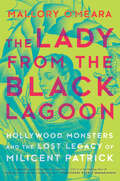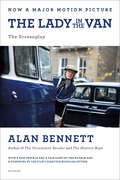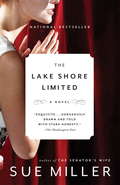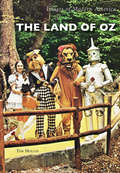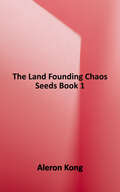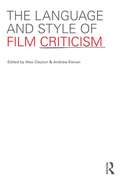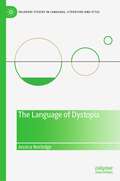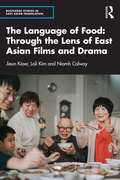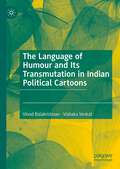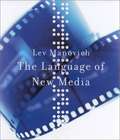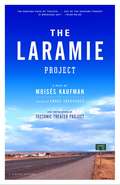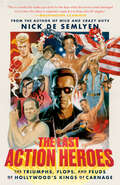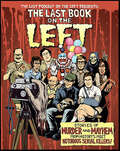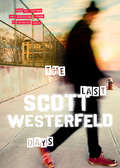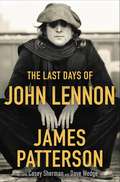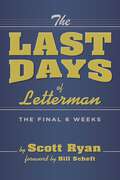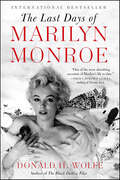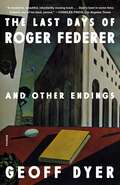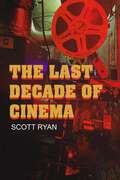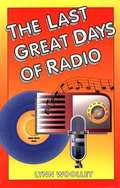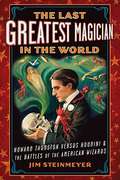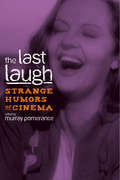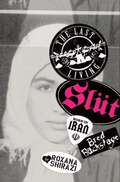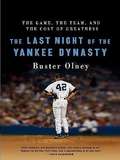- Table View
- List View
The Lady from the Black Lagoon: Hollywood Monsters and the Lost Legacy of Milicent Patrick
by Mallory O'MearaThis acclaimed biography shines a light on a trailblazing woman who created a classic movie monster—and the author’s quest to rescue her from obscurity.As a teenager, Mallory O’Meara was thrilled to discover that one of her favorite movies, Creature from the Black Lagoon, featured a monster designed by a woman, Milicent Patrick. But while Patrick should have been hailed as a pioneer in the genre, there was little information available about her. As O’Meara discovered, Patrick’s contribution had been claimed by a jealous male colleague and her career had been cut short. No one even knew if she was still alive.As a young woman working in the horror film industry, O’Meara set out to right the wrong, and in the process discovered the full, fascinating story of an ambitious, artistic woman ahead of her time. Patrick’s contribution to special effects proved to be just the latest chapter in a remarkable, unconventional life, from her youth growing up in the shadow of Hearst Castle, to her career as one of Disney’s first female animators. And at last, O’Meara discovered what really had happened to Patrick after The Creature’s success, and where she went.A true-life detective story and a celebration of a forgotten feminist trailblazer, Mallory O’Meara’s The Lady from the Black Lagoon establishes Patrick in her rightful place in film history while calling out a Hollywood culture where little has changed since.A Hugo and Locus Award FinalistA Thrillist Best Book of the YearOne of Booklist’s 10 Best Art Books of the Year
The Lady in the Van
by Alan Bennett Nicholas HytnerThe screenplay edition of the major motion picture adaptation, starring Maggie Smith, of Alan Bennett's acclaimed story "The Lady in the Van"From acclaimed author and playwright Alan Bennett, whose smash hit The History Boys won a Tony Award for Best Play, comes the screenplay of The Lady in the Van-soon to be a major motion picture starring Dame Maggie Smith.The Lady in the Van is the true story of Bennett's experiences with an eccentric homeless woman, Miss Mary Shepherd, whom he befriended in the 1970s and allowed to temporarily park her van in front of his Camden home. She ended up staying there for fifteen years, resulting in an uncommon, often infuriating, and always highly entertaining friendship of a lifetime for the author.Read the screenplay of the film destined to be among the most talked about of the year, and discover the unbelievable story of one of the most unlikely-yet heartwarmingly real-relationships in modern literature.
The Lake Shore Limited (Vintage Contemporaries Ser.)
by Sue MillerThat's what the play was about, she was thinking abruptly. The wish to imagine what life could be, how it could change, if you were unencumbered. Did everyone who was married do this from time to time, imagine an unencumbered life? Three years after the death of her younger brother Gus, Leslie still thinks about what might have been: if Gus hadn't got on that plane on September 11th, if her husband understood the nature of her grief, if she had made different choices. As she sits down to watch The Lake Shore Limited, a disquietingly autobiographical play written by Gus's former girlfriend Billy, she can't help but wonder whether she also holds on to the past, and whether she really knows Billy at all. Meanwhile, Sam, Leslie's divorced friend, finds in the play inescapable echoes of his troubled life and begins to fall for Billy's distinctive, enigmatic beauty. A powerful love story; a mesmerising tale of entanglements, connections and inconsolable losses; a marvellous reflection on the meaning of grace and the uses of sorrow, in life and in art: The Lake Shore Limited is Sue Miller at her dazzling best.
The Land of Oz (Images of Modern America)
by Tim HollisIn 1966, North Carolina tourism moguls Grover, Harry, and Spencer Robbins began exploring ways to utilize their new ski facilities atop Beech Mountain during the summer. They brought in their associate Jack Pentes to come up with an idea. As a long-time fan of The Wizard of Oz, Pentes planned and developed the Land of Oz theme park, opening in June 1970. The park did not resemble the famous 1939 MGM movie or the Oz as depicted in L. Frank Baum's book. Instead, Pentes interpreted his own vision of Oz, with a comical Wicked Witch and a wizard who did not turn out to be a fake. The Land of Oz closed after its 1980 operating season and was left to deteriorate. Since 1990, however, its remnants have been secured and restored. The property is now available for special events, and a giant Oz celebration takes place each autumn.
The Land: Founding (Chaos Seeds Ser. #Bk.1)
by Aleron KongAleron Kong has written five novels in his bestselling LitRPG saga, The Land. The journey of Gripping Action, Dark Humor and Epic World Building begins here. Welcome to the greatest game you've never played. When Danger Zone Industries had released the latest and greatest Virtual Reality MMORPG, James, and millions of other virtual reality players, sought purpose and self-definition in this new world. The tag line "Live the life your soul was meant for," captured the hearts and minds of his entire generation. "The Land," was the largest and most dynamic virtual reality game of all time. James and his friends had devoted countless hours to become one of the top teams in the game. None of that mattered after James was actually summoned to The Land. What had been an engrossing game became a daily struggle of life and death. James struggles to survive while becoming embroiled in an age old war between the sprites and goblins, avoiding the machinations of the local king and helping an enslaved woman know freedom once again. Join the sensation! Welcome... to The Land!
The Language and Style of Film Criticism
by Alex Clayton Andrew KlevanThe Language and Style of Film Criticism brings together original essays from an international range of academics and film critics highlighting the achievements, complexities and potential of film criticism. In recent years, in contrast to the theoretical, historical and cultural study of film, film criticism has been relatively marginalised, especially within the academy. This book highlights the distinctiveness of film criticism and addresses ways in which it can take a more central place within the academy and develop in dynamic ways outside it. The Language and Style of Film Criticism is essential reading for academics, teachers, students and journalists who wish to understand and appreciate the language and style of film criticism.
The Language of Dystopia (Palgrave Studies in Language, Literature and Style)
by Jessica NorledgeThis book presents an extended account of the language of dystopia, exploring the creativity and style of dystopian narratives and mapping the development of the genre from its early origins through to contemporary practice. Drawing upon stylistic, cognitive-poetic and narratological approaches, the work proposes a stylistic profile of dystopia, arguing for a reader-led discussion of genre that takes into account reader subjectivity and personal conceptualisations of prototypicality. In examining and identifying those aspects of language that characterise dystopian narratives and the experience of reading dystopian fictions, the work discusses in particular the manipulation and construction of dystopian languages, the conceptualisation of dystopian worlds, the reading of dystopian minds, the projection of dystopian ethics, the unreliability of dystopian refraction, and the evolution and hybridity of the dystopian genre.
The Language of Food: Through the Lens of East Asian Films and Drama (Routledge Studies in East Asian Translation)
by Jieun Kiaer Loli Kim Niamh CalwayThe Language of Food: Through the Lens of East Asian Films and Drama invites readers into the fascinating world where food culture and language intersect, revealing how each dish communicates beyond mere taste.Through East Asian films and television shows, this book uncovers the rich tapestry of 'food languages' embedded within East Asian cultures. Divided into three parts – Base, Ingredients, and Seasoning – this book provides a structured exploration of this phenomenon. The Base section offers philosophical and historical context, while the Ingredients section delves deeper into specific themes, using examples from film and television drama to illustrate the nuanced communication inherent in food culture. Finally, the book is 'seasoned' with linguistic insights and a practical food words glossary, aiding readers in navigating the intricate verbal and cultural nuances at play. This illuminating resource goes beyond the realm of food itself, offering a profound understanding of how each dish carries its language, enriching communication and deepening cultural connections.This book will captivate students and researchers of East Asian languages, media studies, film studies, food studies, and Korean Wave studies and anyone intrigued by the intricate relationship between food and language.
The Language of Humour and Its Transmutation in Indian Political Cartoons
by Vinod Balakrishnan Vishaka VenkatThis book develops a model to examine the language of humour, which is multimodal and accounts for the possibility of transmutation of humour as it is performed through editorial cartoons. By transmutation is meant the transition in the language of humour when it crosses its own boundaries to provoke unprecedented reactions resulting in offensiveness, disappointment or hurt sentiment. The transmutability about the language of humour points to its inherently diabolical nature which manifests in the performance of controversial cartoons. The model is built by borrowing theoretical cues from Roman Jakobson, Roland Barthes, George Lakoff and Mark Johnson. The integrated model, then, is developed to examine the cartoons which were recommended for deletion by the Thorat Committee, following a cartoon controversy in India. Through the cartoon analysis, the model discerns the significance of context and temporality in determining the impact of humour. It also examines how the ethics of humour; the blurred lines of political correctness and incorrectness are dictated by the political atmosphere and the power dynamics.
The Language of Life and Death
by William LabovWe share the experience of others through the stories they tell of the crucial events in their lives. This book provides a rich range of narratives that grip the reader's attention together with an analysis of how it is done. While remaining true to the facts, narrators use linguistic devices to present themselves in the best possible light and change the listener's perception of who is to blame for what has occurred. William Labov extends his widely used framework for narrative analysis to matters of greatest human concern: the danger of death, violence, premonitions, and large-scale community conflicts. The book also examines traditional epic and historical texts, from Herodotus and the Old Testament to Macaulay, showing how these literary genres draw upon the techniques of personal narratives. Not only relevant to students of narratology, discourse and sociolinguistics, this book will be rewarding reading for anyone interested in the human condition.
The Language of New Media
by Lev ManovichLev Manovich offers the first systematic and rigorous theory of new media. He places new media within the histories of visual and media cultures of the last few centuries.
The Laramie Project
by Moises KaufmanOn October 7, 1998, a young gay man was discovered bound to a fence in the hills outside Laramie, Wyoming, savagely beaten and left to die in an act of hate that shocked the nation. Matthew Shepard's death became a national symbol of intolerance, but for the people of Laramie the event was deeply personal, and it's they we hear in this stunningly effective theater piece, a deeply complex portrait of a community.
The Last Action Heroes: The Triumphs, Flops, and Feuds of Hollywood's Kings of Carnage
by Nick de SemlyenThe behind-the-scenes story of the action heroes who ruled 1980s and &’90s Hollywood and the beloved films that made them stars, including Die Hard, First Blood, The Terminator, and more.&“This book takes you so close to the action that you can smell the sweat, cigar smoke, and bad cologne that brought these movies to life.&”—Paul ScheerThe Last Action Heroes opens in May 1990 in Cannes, with Arnold Schwarzenegger and Sylvester Stallone waltzing together, cheered on by a crowd of famous faces. After years of bitter combat—Stallone once threw a bowl of flowers at Schwarzenegger&’s head, and the body count in Schwarzenegger&’s Commando was increased so the film would &“have a bigger dick than Rambo&”—the world&’s biggest action stars have at last made peace.In this wildly entertaining account of the golden age of the action movie, Nick de Semlyen charts Stallone and Schwarzenegger&’s carnage-packed journey from enmity to friendship against the backdrop of Reagan&’s America and the Cold War. He also reveals fascinating untold stories of the colorful characters who ascended in their wake: high-kickers Chuck Norris and Jackie Chan, glowering tough guys Dolph Lundgren and Steven Seagal, and quipping troublemakers Jean-Claude Van Damme and Bruce Willis. But as time rolled on, the era of the invincible action hero who used muscle, martial arts, or the perfect weapon to save the day began to fade. When Jurassic Park trounced Schwarzenegger&’s Last Action Hero in 1993, the glory days of these macho men—and the vision of masculinity they celebrated—were officially over.Drawing on candid interviews with the action stars themselves, plus their collaborators, friends, and foes, The Last Action Heroes is a no-holds-barred account of a period in Hollywood history when there were no limits to the heights of fame these men achieved, or to the mayhem they wrought, on-screen and off.
The Last Book on the Left: Stories of Murder and Mayhem from History's Most Notorious Serial Killers
by Ben Kissel Marcus Parks Henry ZebrowskiThis “delightfully creepy” New York Times bestseller from the award-winning horror-comedy podcast team takes deep dives into nine infamous serial killers (Booklist).Since its first show in 2010, The Last Podcast on the Left has barreled headlong into all things horror, covering subjects spanning Jeffrey Dahmer, Jonestown, and various supernatural phenomena. Deeply researched but with a morbidly humorous bent, the podcast has earned a dedicated and aptly cultlike following for its unique take on all things macabre.In their first book, the guys take a deep dive into history’s most infamous serial killers, from Ted Bundy to John Wayne Gacy, exploring their origin stories, haunting habits, and perverse predilections. Featuring newly developed content alongside updated fan favorites, each profile is an exhaustive examination of the darker side of human existence. With appropriately creepy four-color illustrations throughout, The Last Book on the Left will satisfy the bloodlust of readers everywhere. “A fully illustrated compendium that revisits in print nine of the most notorious killers covered on the podcast, re-investigating the subjects and going through two rounds of fact-checking to provide definitive accounts of murderers from John Wayne Gacy to the Son of Sam to Soviet serial killer Andrei Chikatilo, which at the same time question their mythical status in our collective psyche and nightmares.”–Rolling Stone
The Last Days (Peeps #2)
by Scott WesterfeldStrange things are happening: people going crazy in the streets, old friends disappearing, angels (or devils) clambering on the fire escapes of New York City. But for Pearl, Moz and Zahler, all that matters is their new band. As the city reels under a mysterious epidemic, the three combine their talents with a vampire lead signer and a drummer whose fractured mind can glimpse the coming darkness. Will their music stave off the end of the world? Or summon it? Set against the gritty apocalypse that began in Parasite Positive, THE LAST DAYS is about five teenagers who find themselves creating the soundtrack for the end of the world.
The Last Days of John Lennon
by James PattersonThe greatest true-crime story in music history, as only James Patterson can tell it. With the Beatles, John Lennon surpasses his youthful dreams, achieving a level of superstardom that defies classification. “We were the best bloody band there was,” he says. “There was nobody to touch us.” <P><P>Nobody except the original nowhere man, Mark David Chapman. Chapman once worshipped his idols from afar—but now harbors grudges against those, like Lennon, whom he feels betrayed him. He’s convinced Lennon has misled fans with his message of hope and peace. And Chapman’s not staying away any longer. By the summer of 1980, Lennon is recording new music for the first time in years, energized and ready for it to be “(Just Like) Starting Over.” He can’t wait to show the world what he will do. <P><P>Neither can Chapman, who quits his security job and boards a flight to New York, a handgun and bullets stowed in his luggage. The greatest true-crime story in music history, as only James Patterson can tell it. Enriched by exclusive interviews with Lennon’s friends and associates, including Paul McCartney, The Last Days of John Lennon is the thrilling true story of two men who changed history: One whose indelible songs enliven our world to this day—and the other who ended the beautiful music with five pulls of a trigger. <P><P><b>A New York Times Bestseller</b>
The Last Days of Letterman
by Scott RyanA brilliants look behind the scenes at not only the making of a television show, but also the curtain call of one of America's greatest entertainers and the impact his impending departure will have on the many talented people who work so hard to put the show together but never -- until now -- got the credit they deserved.On May 20, 2015, Dave said, "Thank you and goodnight." The Foo Fighters sang "Everlong," and Late Show with David Letterman ended its run. The final six weeks of the series had guests like Julia Roberts, George Clooney, Oprah Winfrey, and the Obamas. All names you have heard many times. But it was the people behind the scenes who pulled off these twenty-eight unforgettable episodes of late-night television.Author Scott Ryan conducted over twenty interviews with the staffers of David Letterman. Most of the participants had never given interviews before. The writers, directors, producers, and stage managers offer a behind-the-scenes look at what it was like to work on these shows. Find out what it takes to write a Top Ten list, book a president for a guest spot, and what it was like working at the Ed Sullivan Theater.Long time Letterman writer Bill Scheft penned the foreword for the book. Included are over 100 color photos from staffers' personal collections, as well as publicity photos from the show. Get the first truly inside look at creating an episode of Late Show.Interviews with: Barbara Gaines - Executive Producer; Sheila Rogers - Supervising Producer/ Talent Executive; Randi Grossack - Associate Director; Kathy Mavrikakis, Supervising Producer; Rick Sheckman, Associate Producer; Brian Teta - Supervising Producer/Segment Producer; Sheryl Zelikson - Music Producer; Jay Johnson - Creative Director, Digital Media; Jerry Foley - Director; Michael Barrie - Writer; Lee Ellenberg - Writer; Jim Mulholland - Writer; Joe Grossman - Writer; Jeremy Weiner - Writer; Steve Young - Writer; Vincent Favale - Executive of Late Night Programing; Eddie Valk - Stage Manager; Bill Scheft - Writer; Janice Penino - Vice President, Human Resources; Jill Goodwin - Writer; and Mike Buczkiewicz - Senior Producer/Segment Producer; Rupert Jee - Hello Deli Owner.
The Last Days of Marilyn Monroe
by Donald H. WolfeMarilyn Monroe's death has been shrouded in decades of deception, conspiracy, and lies. Donald H. Wolfe has written a startling portrait of the twentieth century's greatest film star that not only redefines her place in entertainment history but also reveals the secret conspiracy that surrounded her last days.In The Last Days of Marilyn Monroe, Wolfe confirms that the tragic actress was a homicide victim. He documents the mode of death, and names those involved and those who participated in the cover-up. Filled with documented revelations, eye-opening information about the dark secret in Marilyn's relationship with John and Robert Kennedy, and shocking details about the many bizarre events that took place at Marilyn's home the day she died, Donald H. Wolfe's remarkable book is the culmination of more than seven years of research. It will change forever the way we view the life—and death—of this great star.
The Last Days of Roger Federer and Other Endings
by Geoff DyerOne of Esquire's best books of spring 2022An extended meditation on late style and last works from "one of our greatest living critics" (Kathryn Schulz, New York).When artists and athletes age, what happens to their work? Does it ripen or rot? Achieve a new serenity or succumb to an escalating torment? As our bodies decay, how do we keep on? In this beguiling meditation, Geoff Dyer sets his own encounter with late middle age against the last days and last works of writers, painters, footballers, musicians, and tennis stars who’ve mattered to him throughout his life. With a playful charm and penetrating intelligence, he recounts Friedrich Nietzsche’s breakdown in Turin, Bob Dylan’s reinventions of old songs, J. M. W. Turner’s paintings of abstracted light, John Coltrane’s cosmic melodies, Bjorn Borg’s defeats, and Beethoven’s final quartets—and considers the intensifications and modifications of experience that come when an ending is within sight. Throughout, he stresses the accomplishments of uncouth geniuses who defied convention, and went on doing so even when their beautiful youths were over. <p><p>Ranging from Burning Man and the Doors to the nineteenth-century Alps and back, Dyer’s book on last things is also a book about how to go on living with art and beauty—and on the entrancing effect and sudden illumination that an Art Pepper solo or Annie Dillard reflection can engender in even the most jaded and ironic sensibilities. Praised by Steve Martin for his “hilarious tics” and by Tom Bissell as “perhaps the most bafflingly great prose writer at work in the English language today,” Dyer has now blended criticism, memoir, and humorous banter of the most serious kind into something entirely new. The Last Days of Roger Federer is a summation of Dyer’s passions, and the perfect introduction to his sly and joyous work.
The Last Decade of Cinema: Twenty-five Unique Films From The Nineties
by Scott RyanThis provocative tome, sure to foment heated discussions among cinephiles of all generations, argues that the 1990s was the last decade in which films were made for grownups, with complex, adult-based plots, nuanced characters, and meaningful themes.&“I feel like Scott Ryan could have written this directly to me and others in our generation who have basically &‘given up&’ on movies. It is at once tribute and eulogy, so bittersweet.&” – Screenwriter Helen Childress (Reality Bites)&“The nineties are lucky to have Scott Ryan.&” – Actress Natasha Gregson Wagner (Two Girls and a Guy, Lost Highway)Ah, the nineties. Movies were something in those days. We&’re talking about a decade that began with GoodFellas and ended with Magnolia, with such films as Malcolm X, Before Sunrise, and Clueless arriving somewhere in between. Stories, characters, and writing were king; IP, franchise movies, and supersaturated superhero flicks were still years away. Or so says Scott Ryan, the iconoclastic author of The Last Days of Letterman and Moonlighting: An Oral History, who here turns his attention to The Last Decade of Cinema—the prolific 1990s. Ryan, who watched just about every film released during the decade when he was a video store clerk in a small town in Ohio, identifies twenty-five unique and varied films from the decade, including Pretty Woman, Pulp Fiction, Menace II Society, The Prince of Tides, and The Shawshank Redemption, focusing with his trademark humor and insight on what made them classics and why they could never be produced in today&’s film culture. The book also includes interviews with writers, directors, and actors from the era. Go back to the time of VCR&’s, DVD rentals, and movies that mattered. Turn off your streaming services, put down your phones, delete your Twitter account, and take a look back at the nineties with your Eyes Wide Shut, a White Russian in your hand, and yell &“Hasta la vista, baby&” to today&’s meaningless entertainment. Revel in the risk-taking brilliance of Quentin Tarantino, Amy Heckerling, Spike Lee, Robert Altman, Paul Thomas Anderson, and others in Scott Ryan&’s magnum opus, The Last Decade of Cinema.
The Last Great Days of Radio
by Lynn WoolleyIf you've ever wanted to be in radio--or ever wondered what was happening on the other side of the dial, then this book is for you. You'll find out what it's like to get that first job, to work in Texas's largest newsroom, to cover a major murder trial, to cover the President of the United States, to follow the Dallas Cowboys to the Super Bowl, and to create top-rated comedy routines. Full of inside information about the radio business, this book touches on the careers of dozens of well-known broadcasters. Long time radio personality Lynn Woolley introduces you to the laughs and times of Texas radio in its heyday. A mixture of humor, wit, and nostalgia, this book follows the career of Woolley from the smallest station in a small market to the largest radio newsroom in Texas, and back again.
The Last Greatest Magician in the World: Howard Thurston Versus Houdini & the Battles of the American Wizards
by Jim SteinmeyerHere is the seminal biography of the magician's magician, Howard Thurston, a man who surpassed Houdini in the eyes of showmen and fans and set the standard fro how stage magic is performed today. Everyone knows Houdini-but who was Thurston? In this rich, vivid biography of the "greatest magician in the world," celebrated historian of stage magic Jim Steinmeyer captures the career and controversies of the wonder-worker extraordinaire, Howard Thurston. The public's fickleness over magicians has left Thurston all but forgotten today. Yet Steinmeyer shows how his story is one of the most remarkable in show business. During his life, from 1869 to 1936, Thurston successfully navigated the most dramatic changes in entertainment-from street performances to sideshows to wagon tours through America's still-wild West to stage magic amid the glitter of grand theaters. Thurston became one of America's most renowned vaudeville stars, boldly performing an act with just a handful of playing cards, and then had the foresight to leave vaudeville, expanding his show into an extravaganza with more than forty tons of apparatusand costumes. His touring production was an American institution for nearly thirty years, and Thurston earned a brand name equal to Ziegfeld or Ringling Brothers. Steinmeyer explores the stage and psychological rivalry between Thurston and Houdini during the first decades of the twentieth century- a contest that Thurston won. He won with a bigger show, a more successful reputation, and the title of America's greatest magician. In The Last Greatest Magician in the World, Thurston's magic show is revealed as the one that animates our collective memories.
The Last Laugh: Strange Humors of Cinema (Contemporary Approaches To Film And Media Ser.)
by Murray PomeranceFor critics, fans, and scholars of drama and film, the laugh has traditionally been tied to comedy, indicating and expressing mirth, witty relief, joyous celebration, or arch and sarcastic parody. But strange, dark laughter that illuminates non-comedic, unfunny situations gets much less attention. In The Last Laugh: Strange Humors of Cinema, editor Murray Pomerance has assembled contributions from thirteen estimable scholars that address the strange laughter of cinema from varying intellectual perspectives and a wide range of sources. Contributors consider unusual humors in a variety of filmic settings, from the chilling unheard laughter of silent cinema to the ribald and mortal laughter in the work of Orson Welles; the vagaries and nuances of laughter in film noir to the eccentric laughter of science fiction. Essays also look at laughter in many different applications, from the subtle, underlying wit of the thriller Don't Look Now to the deeply provocative humor of experimental film and the unpredictable, shadowy, insightful, and stunning laughter in such films as Black Swan, Henry Fool, The Treasure of the Sierra Madre, Kiss of Death, The Dark Knight, and A.I. Artificial Intelligence. The accessibly written, unique essays in The Last Laugh bring a new understanding to the delicate balance, unsettled tensions, and fragility of human affairs depicted by strange humor in film. For scholars of film and readers who love cinema, these essays will be rich and playful inspiration.
The Last Living Slut: Born in Iran, Bred Backstage
by Roxana ShiraziThe Last Living Slut is the salaciously literary and sexually liberated memoir about Roxana Shirazi’s evolution from traditional Iranian to rock groupie.“Makes Pamela Des Barres’ I’m With the Band read like a nun’s diary in comparison. . . . The most gripping real-life account of female depravity we’ve ever read.” —New York Times–bestselling authors Neil Strauss and Anthony Bozza, from their IntroductionBorn in Tehran and raised within the strictures of Muslim religious culture, Roxana Shirazi’s life changed when her family immigrated to London, fleeing the Iranian Revolution. Thrust into an uptight environment where she was racially bullied, she found refuge in the sounds of hard rock and heavy metal, becoming obsessed with living the sex, drugs, and rock ‘n’ roll lifestyle that the music celebrated. When not pursuing her Masters degree in English, Roxana was attending rock concerts, pursuing her favorite musicians and exploring her voracious sexuality. Partying with members of Guns N' Roses, Mötley Crüe, Velvet Revolver, and other bands past their 80s hair metal prime, she pushed herself and her rock star conquests to sexual extremes.“Raw and real” (Orlando Sentinel), The Last Living Slut is a passionate tale of jilted love, brutal revenge, and backstage encounters from a woman who rocked harder than most metalheads—and their guitar slinging heroes—would have ever dared.
The Last Night of the Yankee Dynasty: The Game, the Team, and the Cost of Greatness
by Buster OlneyFor several years the Yankees were unstoppable World Series champs. Olney describes the lives of the players, coaches, and managers during this time. He outlines scandals, strategies, and memorable plays, while arguing that the philosophy that made the team great was also harmful and inevitably lead to its eventual defeat.
